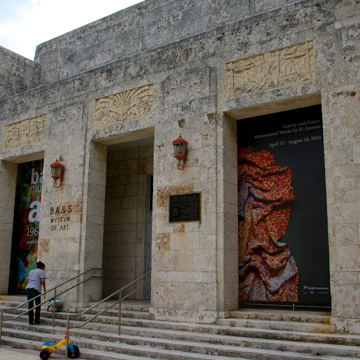The Bass Museum was built as the John Collins Memorial Library and Art Center between 1930 and 1934. Russell Pancoast designed the elegant Art Deco building to reflect the symmetry of the formal gardens in Collins Park, which were planted in the 1920s and donated to the city by the architect’s grandfather, Miami Beach pioneer John A. Collins. The library housed the first public space for exhibiting art in the Miami area, and after the construction of the new library in Collins Park in 1962, the older building was turned over to a new institution, the Bass Museum of Art.
Intended to inject civic pride in the young city at the onset of the Great Depression, the building became one of Miami Beach’s first examples of Art Deco, the style that would henceforth come to define the city’s built environment. Pancoast synthesized multiple sources in his design; the structure makes strong references to the austere stripped classicism of Paul Philippe Cret’s Folger Shakespeare Library, whose sculptural program also proved influential, and to the spectacular pavilions erected at the 1925 Paris Exposition International des Arts Decoratifs et Industriels Moderne in Paris. Pancoast carefully integrated three additions to the original building between 1937 and 1950.
One feature that distinguishes the Bass from later Art Deco buildings in South Beach is its oolitic limestone (or keystone) cladding. The porous material lends the building a rough texture that contrasts strongly with the smooth, machine-like surfaces of Miami Beach’s 1930s hotels. Combined with the building’s stepped massing and carved ornament, the quasi-vermiculated masonry evokes the Mesoamerican architecture of the Yucatán. References to Latin America architecture were common in American Art Deco buildings, but in Miami Beach these allusions assumed another layer of importance because of the region’s aspiration to become the central node linking North and South America. Pancoast drove home this point with a sculptural iconography that included the flying Clipper ships of Miami-based Pan American Airways.
The integration of decorative arts in the building’s principle facade (facing Collins Park) reflects the institution’s intended importance in the cultural life of Miami Beach. The bas relief friezes by sculptor Gustav Boland depict a range of topics—Spanish galleons, pelicans in the fish-rich mangroves, cruise ships, and flying boats—that supported Miami Beach’s mythologizing as a place of historical heritage, natural beauty, and cosmopolitan elegance.
The current museum was born when John and Johanna Bass donated a significant collection of Renaissance and Baroque art to the city in 1962. Robert Swartburg, a prominent local architect whose earlier work included the Delano Hotel, designed the modest modifications required to accommodate larger exhibition spaces. But the major transformation of the building came with the addition built to the designs of Arata Isozaki in 2001. Isozaki’s project reoriented the building to Park Avenue and added significant new exhibition space in a series of galleries elevated one story above grade and accessed by a monumental ramp. Hovering above a reflecting pool, Isozaki’s addition—composed as an ensemble of playful volumes—was intended to work well in both its current, asymmetrical configuration, and as one half of a larger addition that would include its mirror-image twin.
References
Shulman, Allan T., Randall C. Robinson, and James F. Donnelly. Miami Architecture: An AIA Guide Featuring Downtown, the Beaches, and Coconut Grove. Gainesville: University Press of Florida, 2010.








